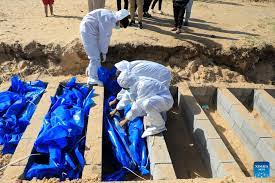Balliet, 27, was referring to 3D-printed firearms. In the same post, on the now-defunct far-right messaging board, Meguca, Balliet wrote, just minutes before carrying out his attack: “Of course, there are dozens of other designs out there, so what’s special with mine? Simple, I prefer live testing.”
He then provided a link to a livestream on the gaming platform, Twitch, which broadcast his gun attack.
In his manifesto, which was also uploaded onto Meguca, apart from his objective of trying to “kill as many anti-Whites as possible, jews preferred”, Balliet also stated that he wanted to “prove the viability of improvised weapons”.
Among the cache of firearms Balliet had in Halle was a sub-machine gun that had 3D-printed plastic components, such as the magazine and grip.
Balliet’s attack is seen as a breakthrough moment among cases of far-right “extremism”, described by several experts as being the first perpetrator that had made and used a weapon from 3D-printed elements.
The world’s first ever gun to be made from a 3D printer was built in 2013 by Cody Wilson, a 25-year-old gun rights activist in the United States.
Ballistics and firearms expert Phillip Boyce, from the British-based firm Forensic Equity, said 3D printed guns have evolved since then, despite the “standard and quality” remaining “about the same”, with various designs now available.
It is no longer just handguns that can be produced from a 3D printer, Boyce said.
“You can have a fully automatic AR15 rifle, or a fully automatic AK47. And normally, those fully automatic weapons have got steel barrels, but the rest of it is plastic,” he added.
Since 2019, there has been an increase in the number of arrests and convictions in a number of European countries and elsewhere of people downloading and or trying to build their own 3D-printed guns. And so far, most seem to have far-right links, experts say.
In April this year, Spanish police raided a workshop that was producing 3D-printed weapons in Santa Cruz de Tenerife, in the Canary Islands. They recovered two 3D printers, a replica assault rifle and several gun barrels. Officers said they had also found manuals on urban guerrilla warfare and white supremacist literature. The owner of the workshop was arrested and charged with illegal possession of weapons.
The next month, two men and a woman were arrested in the British town of Keighley, as part of an investigation into “right-wing terrorism”, police said. All three were charged with possessing components of a 3D-printed firearm. One of the suspects faces an additional charge of disseminating an image of the Oklahoma City bomber, Timothy McVeigh.
And in June, a 15-year-old British girl from Derbyshire was charged with six terror offences, including the possession of a manual on how to make a firearm from a 3D printer.



